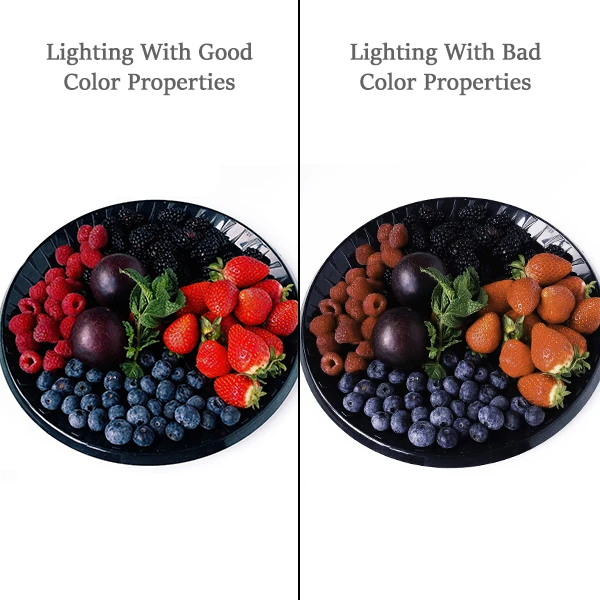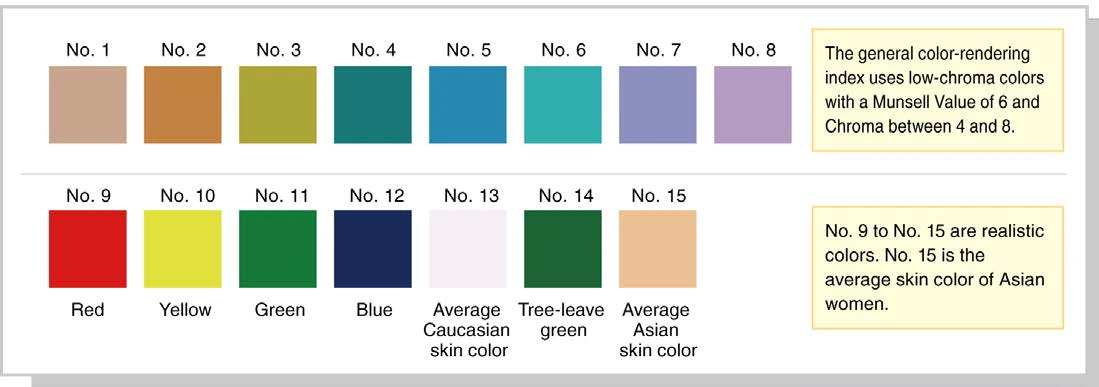การประเมินคุณสมบัติสีของแสง

แสงสว่างมีความสำคัญอย่างยิ่งต่อการใช้งานหลายอย่าง แสงสว่างที่เหมาะสมสามารถช่วยมีอิทธิพลต่อพฤติกรรมการซื้อของผู้บริโภคในร้านค้าปลีกหรือให้ทัศนวิสัยที่เหมาะสมสำหรับศัลยแพทย์ในห้องผ่าตัด– การจัดแสงที่ดีมักสัมพันธ์กับความสว่างและความสว่างที่สม่ำเสมอ แต่นอกเหนือจากการประเมินความสว่างของแหล่งกำเนิดแสงแล้ว การประเมินอุณหภูมิสี (CCT) และคุณสมบัติการแสดงสีก็มีความสำคัญไม่แพ้กัน
อุณหภูมิสี
ในอุตสาหกรรมแสงสว่างซีซีทีบ่งบอกถึงลักษณะสี/ลักษณะของแหล่งกำเนิดแสง เมื่อแสดงหน่วยของอุณหภูมิสัมบูรณ์ที่เรียกว่าเคลวิน (K) แสงจะปรากฏเป็นสีน้ำเงินหาก CCT มากกว่า 4,000k และอะไรก็ตามที่ต่ำกว่านั้นจะมีลักษณะเป็นสีแดง


ดัชนีการแสดงผลสี (CRI)
CRIได้รับการพัฒนาโดยคณะกรรมาธิการระหว่างประเทศว่าด้วยการส่องสว่าง (CIE) ในปี 1965 และปรับปรุงในปี 1974 โดยจะวัดความสามารถของแหล่งกำเนิดแสงในการแสดงสีของวัตถุได้อย่างแม่นยำ เมื่อเปรียบเทียบกับแหล่งอ้างอิงที่คุ้นเคย เช่น แสงกลางวัน
CRI ประกอบด้วยสีมาตรฐาน 8 สี (R1 ถึง R8) และสีพิเศษ 7 สี (R9 ถึง R15) ค่าเฉลี่ย CRI (Ra) คำนวณจากค่าเฉลี่ยของสีมาตรฐานทั้งหมด (R1 ถึง R8) และค่าที่สูงกว่าแสดงถึงคุณภาพแสงที่ดีขึ้น โดย 100 คือค่าสูงสุด
โคนิก้า มินอลต้าสเปกโตรโฟโตมิเตอร์ส่องสว่าง CL-500Aหรือเครื่องวัดความสว่าง CRI CL-70Fสามารถวัดความสว่าง อุณหภูมิสี และ CRI ของแหล่งกำเนิดแสงได้ ทำให้การประเมินแสงสว่างของโซลูชันคุ้มค่าคุ้มราคา
เรียนรู้และทำความเข้าใจแนวคิดพื้นฐานของการวัดแสงและการวัดสีด้วยการศึกษาฟรีของเราหนังสือเล่มเล็ก–
อีกทางหนึ่งติดต่อเราเพื่อรับคำปรึกษาฟรีเกี่ยวกับการประเมินแสงสว่างหรือการสาธิตผลิตภัณฑ์
